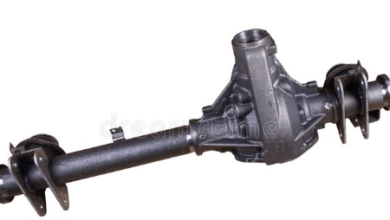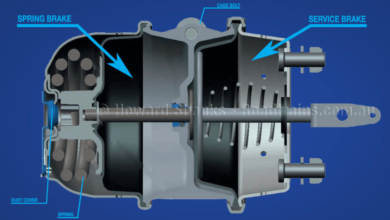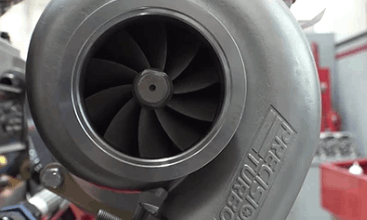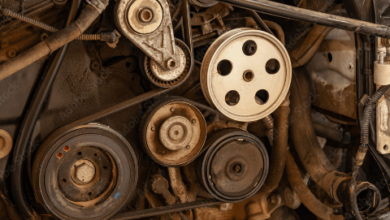Radiator Transmission Cooler – Duty and Types
The water cooling system is very important in your engine. Because it provides the cooling of the heated water in your engine. This system dissipated the excess heat from the engine parts. Without it, probably you can not drive your car because of the overheating problem. Engine cooling systems include different kinds of important parts. One of them is the radiator transmission cooler. Here we explain this part and the replacement cost of it.
What is Radiator Transmission Cooler?
The radiator transmission cooler is a system in which the hot water loses its high temperature. There is the tube, fin, and plate system that cooling fluid passes through it. And the small, fin, tube, and plate systems help to lose the heat of the water.
So, this is the place where the high heat of the engine system is dissipated to the atmosphere. And also, there is a fan that makes this radiator transmission cooler to cool down more rapidly with the forced convection.
They are important if we are driving in hard conditions. Because the engine produces much higher heat that needs to be dissipated.
Types of Radiator Transmission Cooler Systems
There are different kinds of radiator transmission cooler systems that are available for different motors and sizes. And also, there are engine systems that do not have liquid cooling systems. They cool with the convection of the atmospheric air.
Tube and Fin Systems
In these systems, there are small tubings that the cooling fluid passes through them. And there are aluminum fins that help to take the fluid heat from the tube systems. They are very common in old cars with low engine capacities. And also they are the cheapest systems and low efficient cooling systems in general.
Plate and Fin
In these systems, there are plate systems that have fins. Fins are much better at expelling the heat from the water. And also fins have the same duty just as the tube and fin systems. We can easily cool large amounts of fluids more efficiently in plate and fin applications. Also, the prices are higher than the tube and fin systems in general.
Plate-Only Systems
If there is a very big engine application that we are using in hard conditions, they generally need much more efficient cooling systems. Plate-only systems force the fluid to pass through the small plates. The cooling capacity of these types of systems is generally higher. And also they are much more effective than the other systems. In general, we are using this system in the system where we need much higher cooling capacities.
How Much Does It Cost to Replace the Radiator Transmission Cooler Systems?
It changes according to the models that you are using. The radiators are not generally the takes the most money. You can find different models and different kinds of them from $30-100. So, you will be able to change them easily without any problem.
Also, you will need a mechanic to change them. It will be very hard for you to replace these systems if you are not experienced in car mechanics. You need to rip off the fan and cooling system if you want to attach these parts without any problem. Also, the money that you will probably pay to a mechanic for the replacement ranges between $50-100. So the total cost for this replacement will be a maximum $200 for your car.
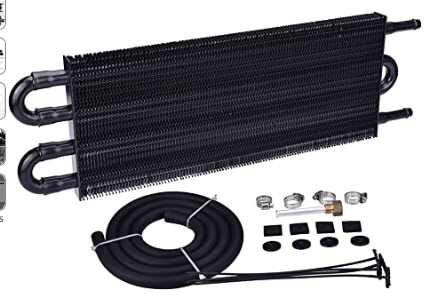
Tube and Fin Radiator Cooler
- Universal applications.
- 4 pass tubes.
- 145 to 900 psi pressure.
This is an example transmission cooler system for tube and fin. Most of the models that you can find on the internet are general tube and fin systems that are generally enough for the average passenger car applications.
- The working temperature is between -40 to 257 degrees Fahrenheit.
- Aluminum alloy material is the best for heat transfer applications.
- 15.75″x5″x0.75″ of sizes.
- 145 psi working pressure with 900 psi bursting pressure.
- Easy to install.
Things to Consider About Radiator Transmission Cooler Systems
These are the important points that we need to consider about selecting a transmission cooler system for our cars.
- Sizes: The size of the system is very important. You need to be sure about if this system fits or not. So you need to know the sizes of your old cooler system and you can compare these sizes with the new system that you are looking for. Also, you need to know the transmission line diameter. Most of the systems are universal systems that will fit with your pipes.
- Working Pressure: The workişng pressure is also very important. You need to be sure about the working pressure of your car cooling system. You can find this information on the type label on your transmission system.
- Working Temperature: The temperature range of the radiator transmission cooler is also very important. You need to consider the maximum and minimum temperatures of the radiator transmission cooler systems in general.
Last Words
These are the important points that you need to know about transmission cooler systems in general. If you have additional questions and comments, leave them below!
Similar posts and articles about car maintenance;
Speedometer Cable in Cars – Everything to Know
Driveshaft Loop Mechanisms – Everything to Know
Is Aftermarket Catalytic Converter Loud? OEM and Mufflers
